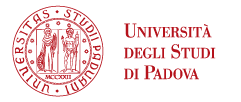Maritime and Coastal Engineering
Piero Ruol, piero.ruol@unipd.it
Luca Martinelli, luca.martinelli@unipd.it
Stefano Meneghin, stefano.meneghin@unipd.it
Matteo Volpato, matteo.volpato@unipd.it
Chiara Favaretto, chiara.favaretto@dicea.unipd.it
Research Areas:
Hydraulic response of maritime structures
The aim of the research is the study of the multiple wave-structure interactions acting on maritime and coastal structures. The research is mainly carried out through experimental investigations in the wave flume and in the wave basin of the ICEA Department.
The analyses are carried out in order to investigate: the stability of rubble mound breakwaters, the forces on vertical wall, the wave overtopping, the harbour agitation, the performance of coastal defence structures, the beach evolution, the efficiency of innovative structures.
The group also studies the behaviour of floating breakwaters, aiming at increasing their efficiency and to find an effective and economical solution.
Wave energy converters
This activity focuses on the research and development of Wave Energy Converter (WEC) devices, with particular reference to low-energy seas, such as the Italian ones, and which allow to combine other functions with energy production (e.g. coastal protection). The research, mainly conducted at the Maritime laboratories, also studies the interactions between the electrical components, the hydrodynamic behaviour of the WECs and the response of their mooring system.
Coastal management and protection
The objective of this research is to propose a single mitigation strategy for coastal erosion as well as a method to assign a priority level, allowing the planning of coastal protection interventions.
Successful management requires a thorough understanding of the physical processes impacting the coast (waves, sea levels, sediment transport) in order to assess the sediment balance and to create a strategic vision of the future, establishing a framework to guide future actions. The method is applied to the whole Venetian littoral.
Coastal flooding risk
The research is based on the application of a numerical model, developed by the research group, which solves the low water equations by using algorithms suitable for the use of GPU graphic memories, to draw up coastal flood hazard maps. The coast of the Veneto Region is a case study, constantly updated, for the application of this research.
Keywords: Coastal engineering; Port engineering; Maritime structures; Wave Energy Converters; Coastal management; Coastal Flooding hazard; Experimental modeling





